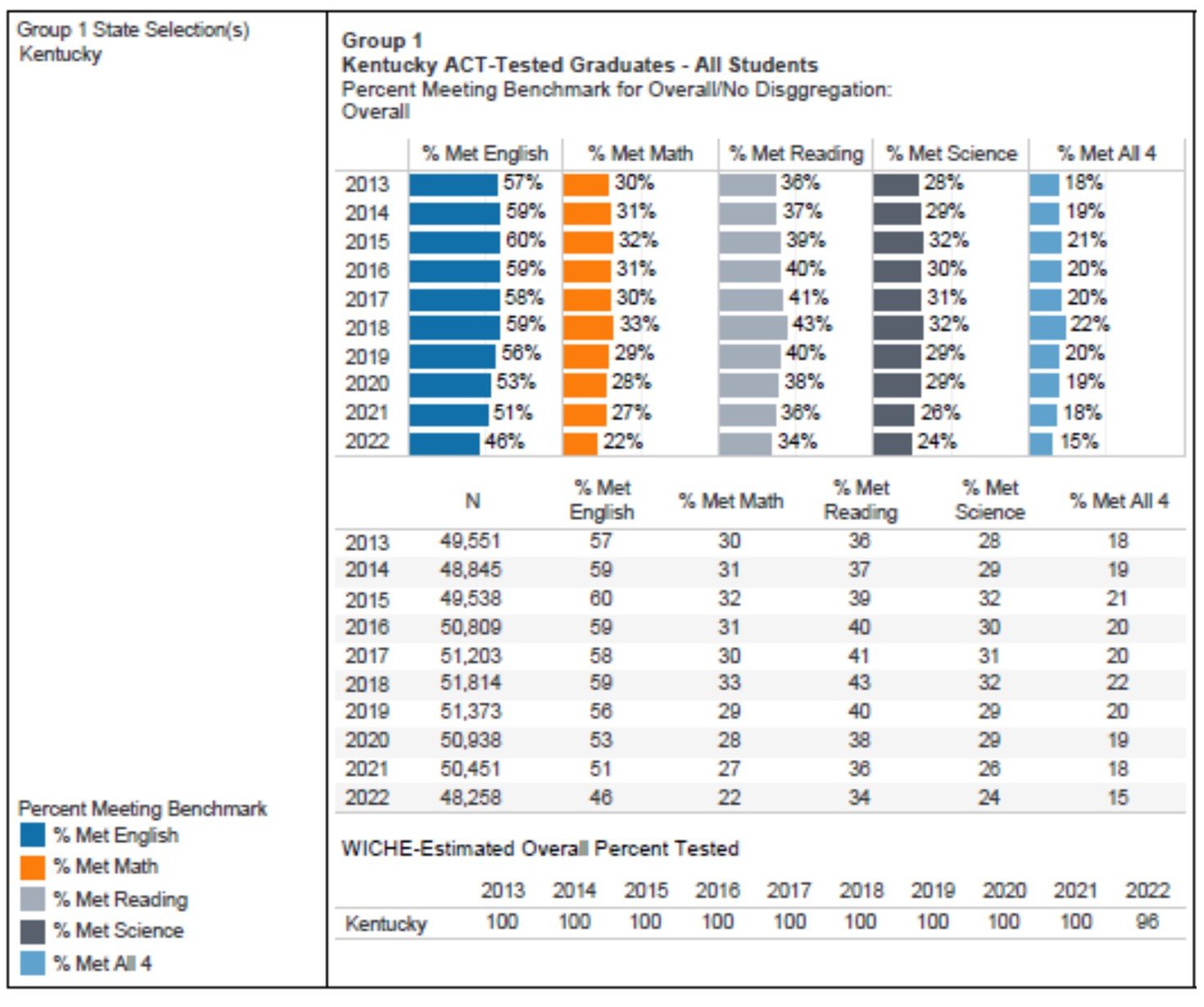More on new reading data from the ACT – and even the Courier-Journal
I’ve done a bit more work with results reported by the ACT Inc. for the 2022 high school graduates. This time I looked at overall ACT Benchmark Score performance by tested subject for all Kentucky students averaged together. This includes public, private and home school students’ overall scores without any disaggregation for things like race, either, making this an “overall, overall” view, if you will. It also should be noted that due to the massive proportion of public school students in this “overall” group (about 90%), the results are close to being what the public schools only would show.
While the latest ACT Benchmark Scores for Kentucky in math and science are particularly disturbing, due to the recent release of Courier-Journal reporter Mandy McLaren’s explosive series about “Between the Lines: Why Kentucky’s kids can’t read and who’s to blame” (subscription required to access), the trend for the percentage of students that met the ACT’s benchmark performance for reading is particularly worth discussion.
As you can see, the success of Kentucky’s graduates in reading on the ACT college entrance test started to fall after 2018, which was before COVID’s disruptions hit. By 2022, the percentage had decayed by 9 percentage points so only one in three students was on target with adequate reading skills to be ready for either college or a living wage career.
In fact, the percentage of Kentucky students meeting ACT’s Reading Benchmark Score performance is now the lowest ever since 2013.
Certainly, major complaints about poor reading performance raised in the Courier-Journal’s reading series are not new. We already had raised some of the same issues previously in our reports “What Milton Wright knew about reading instruction, but lots of teachers apparently don’t” and “Reading proficiency rates rising in some Appalachian schools” and in many blogs dating back years that covered Kentucky’s reading results from the National Assessment of Educational Progress (NAEP).
Our Milton Wright report in particular already raised questions about education schools doing a weak job of preparing new teachers and how the state’s Read to Achieve program was using materials that were coming into serious question for not following what scientific research says works best.
Even Kentucky’s largest-circulation newspaper now gets it, stating things like:
“Students aren’t just failing to meet proficiency. They’re barely able to read.”
The Courier’s newly found awareness and concerns about how reading is taught in Kentucky is a breath of fresh air. It could have come sooner, but we at BIPPS are glad it’s here.
Let’s hope all the attention results in some good things finally happening for the 200,000 struggling readers in Kentucky’s K-12 public schools. Such changes need to include serious efforts to retrain working teachers to use what science shows works best to teach reading along with massive improvements in the college preparation system for teachers.
There’s also a need for increased awareness that students should not be trapped in failing schools and deserve to have other choices when they’re not being taught to read well. After all, as the Courier’s article eloquently points out, the education system in Kentucky has been extremely resistant to obviously needed change for a long time. If the system won’t change, students deserve the right to change their system.
Data Source Information
The Benchmark Score data came from the new ACT Data Visualization Tool, which is something like the NAEP Data Explorer we have used for years. You can access the tool by clicking here.
Then, scroll down to the section headed “Tableau Data View.”
Above the US map, click on the tab titled “Percent Meeting Benchmarks.” This opens up a new web page that allows you to select only Kentucky as the Group 1 State Selection. The data discussed above will then appear in the Group 1 area.

